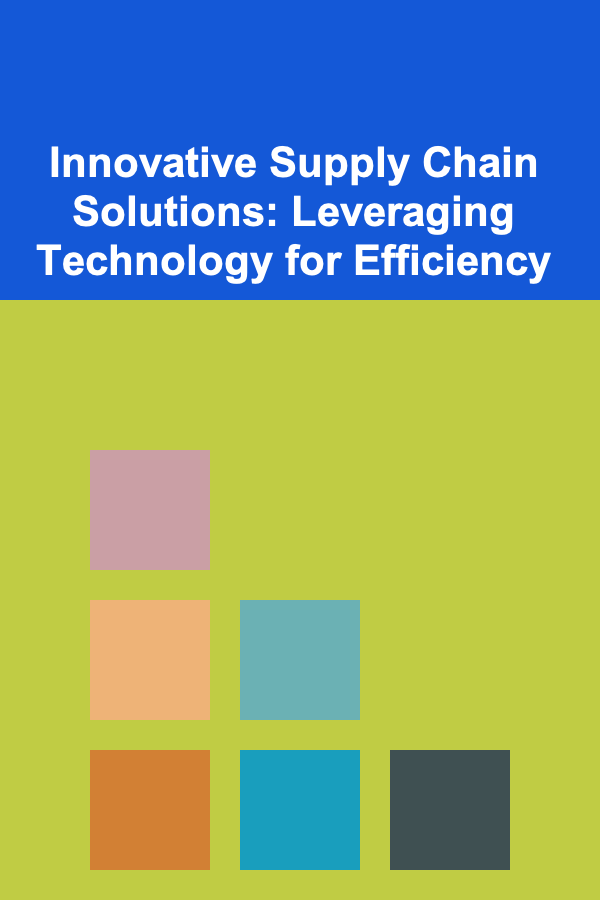
Innovative Supply Chain Solutions: Leveraging Technology for Efficiency
ebook include PDF & Audio bundle (Micro Guide)
$12.99$9.99
Limited Time Offer! Order within the next:

In today's fast-paced and highly competitive market, businesses are constantly seeking ways to improve their supply chain operations to stay ahead of the competition. A key driver of success in this endeavor is technology. The integration of innovative technological solutions has transformed the traditional supply chain into a more dynamic, efficient, and data-driven operation.
This actionable guide explores how organizations can leverage technology to streamline their supply chains, enhance operational efficiency, reduce costs, and improve customer satisfaction. From automation and artificial intelligence to blockchain and IoT, we'll dive into the key technological advancements that are reshaping supply chain management.
Embracing Automation to Streamline Operations
One of the most impactful ways technology is reshaping supply chain management is through automation. By automating routine and time-consuming tasks, businesses can achieve significant improvements in efficiency and accuracy while also freeing up human resources for more strategic initiatives.
Actionable Tactics:
- Automated Warehousing: Automated guided vehicles (AGVs) and robotic systems are revolutionizing warehouse operations. These systems can transport goods from one location to another, pick and pack items, and even manage inventory. The result is faster order fulfillment, fewer errors, and reduced operational costs.
- Robotic Process Automation (RPA): RPA can be applied to repetitive administrative tasks such as processing invoices, updating inventory records, and tracking orders. By automating these processes, companies can reduce manual errors, speed up workflow, and enhance overall productivity.
- Automated Order Fulfillment: Advanced robotics and AI-powered systems are making order fulfillment faster and more accurate. Automated picking systems, such as robotic arms and automated sorting, are helping businesses reduce errors and optimize their fulfillment processes.
Artificial Intelligence and Machine Learning for Predictive Analytics
Artificial Intelligence (AI) and Machine Learning (ML) are enabling businesses to move from reactive to proactive supply chain management. By using these technologies to analyze vast amounts of data, companies can forecast demand, predict supply chain disruptions, and optimize inventory levels.
Actionable Tactics:
- Demand Forecasting: AI-powered tools can analyze historical sales data, market trends, and customer behavior to predict future demand with remarkable accuracy. By improving demand forecasting, businesses can reduce stockouts, minimize overstocking, and optimize inventory levels.
- Predictive Maintenance: AI and ML algorithms can also predict when equipment or machinery is likely to fail. By using predictive maintenance techniques, businesses can schedule maintenance before a breakdown occurs, reducing downtime and avoiding costly repairs.
- Supply Chain Risk Management: AI and ML models can predict potential risks and disruptions in the supply chain, such as supply shortages, delivery delays, or price volatility. By identifying risks early, businesses can take corrective actions before they escalate into major issues.
The Internet of Things (IoT) for Real-Time Visibility
The Internet of Things (IoT) has dramatically transformed the way businesses track and manage inventory and shipments. IoT devices, such as sensors and smart trackers, provide real-time data on the location and condition of goods, improving visibility and decision-making across the supply chain.
Actionable Tactics:
- Real-Time Tracking: By placing IoT sensors on shipments, businesses can track goods in transit in real-time. This enables them to monitor delivery progress, anticipate potential delays, and provide customers with accurate updates on their order status.
- Condition Monitoring: IoT devices can also monitor the environmental conditions of products in transit or storage. For example, temperature-sensitive goods, such as food or pharmaceuticals, can be tracked for temperature fluctuations, ensuring that they remain within safe ranges throughout the supply chain.
- Asset Management: IoT devices help businesses track and manage assets, such as pallets, containers, and trucks. By using IoT-enabled solutions, companies can gain better control over their resources, minimize loss, and ensure that assets are being utilized effectively.
Blockchain Technology for Transparency and Security
Blockchain is an innovative technology that offers a decentralized and immutable ledger system. In the supply chain, blockchain provides transparency, traceability, and enhanced security by recording every transaction or movement of goods in a secure and tamper-proof manner.
Actionable Tactics:
- Enhanced Traceability: Blockchain enables the tracking of products from their origin to the final consumer. By recording each step of the supply chain on the blockchain, businesses can ensure full traceability, which is crucial for industries such as food, pharmaceuticals, and luxury goods, where authenticity and quality are critical.
- Smart Contracts: Blockchain-based smart contracts automate agreements between parties, reducing the need for intermediaries and ensuring faster and more reliable transactions. This can streamline procurement processes, reduce administrative overhead, and improve the efficiency of supplier relationships.
- Fraud Prevention: The immutable nature of blockchain makes it an ideal solution for combating fraud in the supply chain. With blockchain, it's nearly impossible for fraudulent parties to alter or falsify transaction records, helping businesses ensure that their supply chains remain secure and transparent.
Cloud Computing for Scalability and Flexibility
Cloud computing has become a key enabler of flexible and scalable supply chain operations. By moving supply chain management systems to the cloud, businesses can access data and applications remotely, collaborate more effectively with suppliers and customers, and scale operations quickly as needed.
Actionable Tactics:
- Cloud-Based Collaboration: Cloud-based platforms allow businesses to collaborate in real-time with suppliers, distributors, and other stakeholders. These platforms can streamline communication, provide access to shared data, and facilitate faster decision-making, ultimately improving the overall efficiency of the supply chain.
- Scalable Infrastructure: Cloud solutions offer scalability, meaning businesses can quickly adjust their supply chain systems to meet growing demand or changing market conditions. Whether it's scaling up to handle peak seasons or scaling down during slower periods, cloud computing provides the flexibility needed to adapt to fluctuations in business needs.
- Data Integration: Cloud platforms integrate data from different parts of the supply chain, enabling better visibility and smoother operations. By centralizing data storage and access, companies can improve data-driven decision-making, reduce silos, and ensure that all supply chain stakeholders are aligned.
3D Printing for On-Demand Production and Customization
3D printing, also known as additive manufacturing, allows businesses to produce goods and parts on-demand, reducing the need for large inventories and lengthy production times. This technology can be especially useful in industries where customization or rapid prototyping is essential.
Actionable Tactics:
- On-Demand Manufacturing: 3D printing enables businesses to produce products or parts as needed, which can reduce lead times, minimize excess inventory, and lower storage costs. It's especially beneficial for companies with complex or highly customized products, as it allows for quick adjustments to designs.
- Prototyping and Product Development: 3D printing enables rapid prototyping, allowing businesses to test and refine product designs before committing to full-scale production. This can significantly reduce the time and cost associated with product development cycles.
- Localized Production: 3D printing can also support localized production models. By setting up 3D printing facilities closer to key markets or customers, businesses can reduce transportation costs, decrease lead times, and better meet customer demand for customized products.
Leveraging Big Data for Optimized Decision-Making
Big data is another transformative technology in the supply chain. By analyzing large volumes of data from multiple sources, businesses can gain valuable insights that lead to more informed decision-making, from procurement and inventory management to transportation and customer service.
Actionable Tactics:
- Predictive Analytics: Big data analytics can help businesses predict trends, consumer demand, and potential disruptions. By analyzing historical data, external factors, and real-time inputs, companies can make proactive decisions to optimize supply chain operations.
- Optimizing Routes and Deliveries: Analyzing data on traffic patterns, weather, and fuel costs allows businesses to optimize their logistics operations. Big data analytics can identify the most efficient routes for delivery trucks, helping to reduce transportation costs and improve delivery times.
- Improving Customer Insights: Big data also enables businesses to better understand customer preferences and buying behavior. This allows supply chain managers to fine-tune inventory management, personalize marketing efforts, and anticipate customer needs, all of which contribute to improved customer satisfaction.
Conclusion
Technology is no longer a luxury for businesses looking to optimize their supply chains---it's a necessity. By leveraging cutting-edge solutions such as automation, artificial intelligence, IoT, blockchain, and more, businesses can enhance operational efficiency, reduce costs, improve customer experiences, and build a more resilient and agile supply chain.
The key to success in implementing these technologies lies in understanding the unique needs of your business and strategically selecting solutions that will deliver the most value. By continuously embracing innovation and staying ahead of technological trends, companies can not only meet the demands of today's market but also prepare themselves for the challenges of tomorrow's supply chains.

How to Master Combat in Action RPGs
Read More
How to Teach Your Kids Simple Cooking Recipes for Family Fun
Read More
How to Use Clear Containers for Closet Organization
Read More
Top Tips for Creating and Sticking to a Monthly Budget Without the Stress
Read More
How To Choose the Right Lip Scrub for Smoothness
Read More
Marketing Your Services as a Remote Worker: A Comprehensive Guide
Read MoreOther Products

How to Master Combat in Action RPGs
Read More
How to Teach Your Kids Simple Cooking Recipes for Family Fun
Read More
How to Use Clear Containers for Closet Organization
Read More
Top Tips for Creating and Sticking to a Monthly Budget Without the Stress
Read More
How To Choose the Right Lip Scrub for Smoothness
Read More